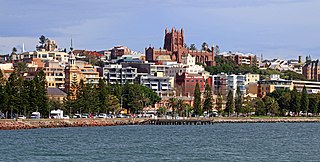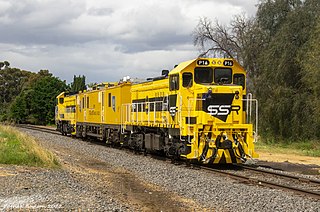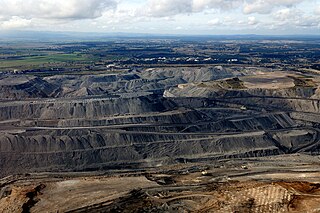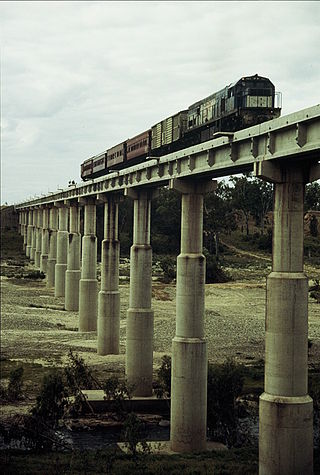
Greater Newcastle is a regional metropolitan area and the second-most-populated district in New South Wales, Australia. It includes the cities of Newcastle and Lake Macquarie; it is the hub of the Lower Hunter region, which includes most parts of the local government areas of City of Newcastle, City of Lake Macquarie, City of Maitland, City of Cessnock and Port Stephens Council.

The Adelaide–Darwin railway line is a railway line in Australia, between the South Australian town of Tarcoola and the Northern Territory city of Darwin. Preceded by a number of other shorter railways, a line through to Darwin was fully realised in 2004 when the final link from Alice Springs to Darwin was opened. Forming the main section of the 2,975 kilometres (1,849 mi) rail corridor between the cities of Adelaide and Darwin, the line is used by The Ghan passenger train and interstate freight trains operated by Aurizon.

The Main North Line is a major railway in New South Wales, Australia. It runs through the Central Coast, Hunter and New England regions. The line was the original main line between Sydney and Brisbane, however this required a change of gauge at Wallangarra. As of 1988, the line closed progressively north of Armidale with services gradually withdrawn till 2004, with the main route between Sydney and Brisbane now the North Coast line.

The Sandgate Flyover is a grade-separated railway flyover that carries the Main North Line across the Kooragang Island line, located in Sandgate, in the City of Newcastle local government area of New South Wales, Australia.

The Port of Newcastle is a major seaport in the city of Newcastle, New South Wales, Australia. It is the world's largest coal port.

Hexham railway station is located on the Main Northern line in New South Wales, Australia. It serves the western Newcastle suburb of Hexham, and was opened on 1 August 1871.
The Vadinar refinery is an oil refinery at Vadinar, Gujarat, India. It is owned and operated by Nayara Energy Limited, in which Rosneft owns a 49.13% stake. The refinery is India's second largest single-location refinery, with an annual capacity of 20 million tonnes and a complexity of 11.8, which also makes it among the world's most complex refineries.

Southern Shorthaul Railroad is an Australian rail freight services operator in New South Wales and Victoria. The company also provides workshop services, such as rolling stock manufacturing and wagon and locomotive maintenance.

The 90 class are a class of heavy haul diesel-electric locomotives built by Electro-Motive Division, Canada for FreightCorp and EDi Rail, Cardiff for Pacific National for use on high tonnage Hunter Valley coal workings.

Coal is mined in every state of Australia. The largest black coal resources occur in Queensland and New South Wales. About 70% of coal mined in Australia is exported, mostly to eastern Asia, and of the balance most is used in electricity generation. In 2019-20 Australia exported 390 Mt of coal and was the world's largest exporter of metallurgical coal and second largest exporter of thermal coal.

Kooragang is the northernmost and largest suburb of the city of Newcastle, in the Hunter Region of New South Wales, Australia. Dominated by Kooragang Island, the eastern part of the suburb is primarily industrial, while the western part of the suburb consists of nature reserves. Covering an area of 35.4 km2 (13.7 sq mi), at the 2016 census, there were no people living in the suburb.
The South Waratah Colliery was a coal mine located at Charlestown, in New South Wales Australia.
Archaeological evidence indicates that human beings have inhabited the area around Newcastle, New South Wales for at least 6500 years. In 2009, archaeologist uncovered over 5,534 Aboriginal artefacts, representing three occupation periods. In the 1820s, the Reverend Lancelot Threlkeld worked with local Awabakal man Biraban to record the Awabakal language. Since 1892, the Indigenous people of Newcastle have come to be known as the Awabakal.
Cape Lambert is a port facility operated by Rio Tinto Iron Ore in the Pilbara region of Western Australia. It is located 40 kilometres north of Karratha.
÷Some of the more notable coal companies in Australia are the following:

Port Kembla is a man-made cargo port or artificial harbour, with an outer harbour protected by breakwaters and an inner harbour constructed by dredging, located in the Illawarra region of New South Wales, Australia.

The Collinsville – Newlands – North Goonyella line, also known as the Goonyella – Abbot Point (GAP) line and the Newlands railway system, is a railway line in Queensland, Australia. It was opened in a series of sections between 1922 and 2012. It commences at Merinda, near Bowen and extends south to North Goonyella coal mine, connecting to the Goonyella railway line. The nearby 13 km line from Kaili to Abbot Point is considered part of the GAP system.
The Newcastle Agri Terminal (NAT) is an intermodal dry bulk cargo port operator located in Carrington, New South Wales. It is located within the Carrington Precinct of the Port of Newcastle utilising the Dyke 2 berth.

Port Management Company is the Russian stevedore company fulfilling the powers of the sole executive body of the specialized coal sea ports of Russia located in the Far East and in the Baltic Sea region.
The coastal coal-carrying trade of New South Wales involved the shipping of coal—mainly for local consumption but also for export or coal bunkering—by sea to Sydney from the northern and southern coal fields of New South Wales. It took place in the 19th and 20th centuries. It should not be confused with the export coal trade, which still exists today. There was also an interstate trade, carrying coal and coke to other Australian states that did not have local sources of black coal.
















